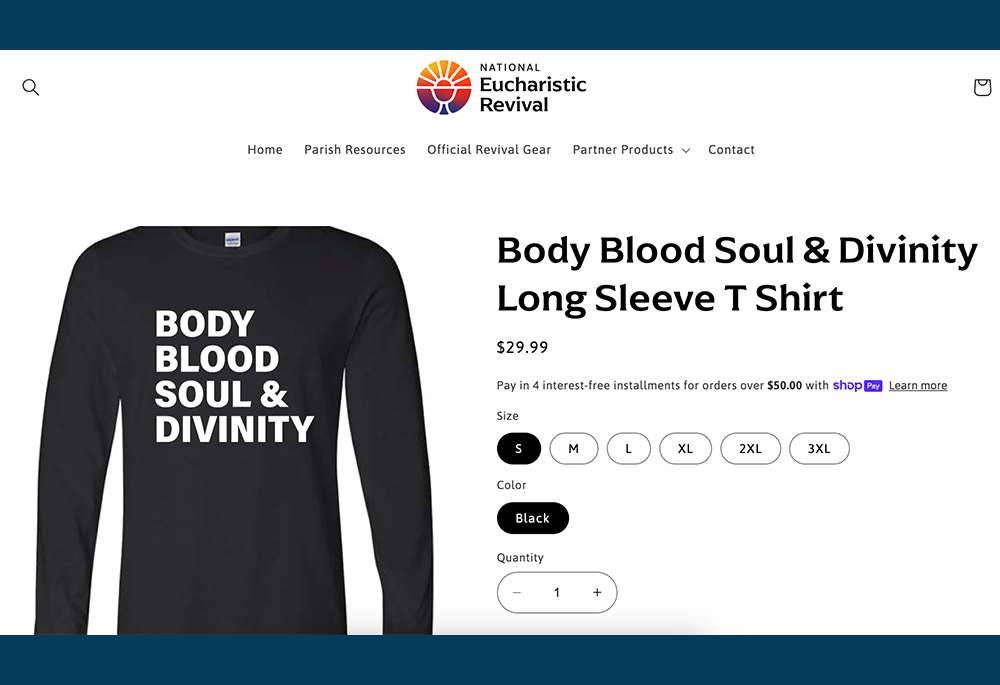
A screengrab displays the "Body, Blood, Soul & Divinity" T-shirt available for purchase via the store of the National Eucharistic Revival website. (NCR screengrab/store.eucharisticrevival.org)
Many have been suspicious of the National Eucharistic Revival being promoted by the U.S. Catholic bishops. The photo on the homepage demonstrates the reason for the concern: You see a priest's hands holding aloft a chalice and the consecrated host. It is almost disembodied. Eucharist is an action, a verb, a thanksgiving in which the church participates in the passion, death and resurrection of the Lord. None of that gets conveyed by the solitary image that adorns the homepage.
Connecting the Catholic faith with American culture has never been easy. Papists were outlaws in Puritan New England and persecuted in most of the colonies. Catholics were legally tolerated in the early republic, but a mob burned the Ursuline convent in Charlestown, Massachusetts, in 1834. The only political party formed specifically to oppose a religion was the antebellum "Know-Nothing Party" and it opposed Catholicism, even throwing a piece of marble Pope Pius IX had sent for the construction of the Washington Monument into the Potomac River in 1854. Al Smith, the first Catholic to seek the presidency, was crushed when he ran in 1928.
In our time, Catholics are as American as apple pie and nothing demonstrates the degree to which we have acclimated to the ambient consumerist culture more than the swag being sold as part of the National Eucharistic Congress.
Some had hoped the emphasis on eucharistic adoration in the congress' material — monstrances abound on the website — might mean the gathering in Indianapolis would be a source of unity between those who prefer the pre-Vatican II liturgy and those who like the novus ordo. Nope. It is hard to believe traditional Catholics, however, will approve of the "Adoration Throw Pillow" ($41.99). Dad leaning against a pillow with a symbolic image of a monstrance, while throwing back a beer and watching the game seems incongruous, even if the words "O Salutaris Hostia" are stitched into it.

Screengrab featuring the "Adoration Throw Pillow" (NCR screengrab/store.eucharisticrevival.org)
Nothing says "Catholic devotion" like a pair of "Monstrance Adult Socks," a steal at only $15.99. They are available in black, "coffee," red, "forest," and navy, and are emblazoned with several images of different monstrances.
The "Body, Blood, Soul & Divinity" T-shirts ($29.99) are only available in black, and they look a tad austere, no fancy image of a monstrance or of the saints. It comes in S, M, L, XL, 2XL, and 3XL.
Now, any vibrant religion produces kitsch. If you go into the gift shop at the Washington National Cathedral, the Episcopal cathedral in our nation's capital, all the objects for sale are exceedingly tasteful. The place screams "classy" and proves the old theological dictum: "Episcopalians will not get to heaven on their good works but on their good taste." By contrast, the gift shops at the Franciscan Monastery and the National Shrine are filled with tacky items, my favorite of which was a battery-operated pendant in which a little red light blinked from the very center of the Sacred Heart of Jesus. Plastic figurines predominate. Images of Mary and the saints adorn paper fans. It is all blessedly plebeian.
There is nothing kitschy about the $39 "official rosary" for the National Eucharistic Congress. "The Centerpiece is a replica of the Monstrance blessed by the Holy Father Pope Francis that will be used at the 10th National Eucharistic Congress," the promotional material states. The crucifix is inspired by John 15:1-5 ("I am the true vine …") and features a cross made of thick vines, with grapes growing. "Limited quantities available" we are warned.
The Lord said, "Feed my sheep," not "Fleece my sheep."
Advertisement
The fleecing, however, is not the biggest problem. The biggest problem is that it should be obvious to all that participating in consumer culture comes at a cost. Consumerism is the enemy of the very spiritual interiority that is the objective of eucharistic adoration. It is the enemy of all interiority. It lulls people into thinking that their value consists in what they possess, not in who they are. It depersonalized the self, reducing us from children of God to consumers in the marketplace.
Earlier in his pontificate, in one of his sermons at the Santa Marta chapel, Pope Francis said, "To waste time — if I may say it — before the Lord, before the mystery of Jesus Christ. To adore, there in the silence, in the silence of adoration. He is the Lord, and I adore him." Consumer culture turns time "wasted" in prayer as leisure time to be exploited.
During a general audience last year, Pope Francis reflected on the life of St. Charles de Foucauld, and asked, "And do we, I ask myself, believe in the power of the Eucharist? Does our going out to others, our service, find its beginning and its fulfillment there, in adoration?" This link between adoration and service has no corollary in the marketplace. Indeed, both adoration and service are impediments to consumerism, and not just impediments but threats.
We all understand that the church needs to keep the lights on. Our Catholic propensity for passing the collection plate is the stuff of jokes. But the commercialization of the eucharistic congress is at cross-purposes with the event itself. And it isn't clear the organizers even gave it a second thought. Remember that the next time a conservative Catholic says we need to be more countercultural.








